
Remunerations are dominated by the market. What is the bellFace-style personnel system in which employees create a “CV” every year?
Technologies and marketing techniques progress every single day.
It has been a long time since both “labor work” and “accounting”, as well as even “motivation management”, have been in the cloud system. However, “sales” still strangely remain unchanged. While the know-how for top sales is still covered in veils, instincts and perseverance of employees have been influential for a few decades.
“Sales and technologies” have been incompatible just like “water and oil”.
In the meantime, bellFace have developed an inside sales system that specializes in sales, and have spread this method all over Japan, which has been already widely known overseas.
Take a look at this graph.

Around 2015 when bellFace was founded, the number of online searches for “inside sales” was almost “zero”. However, within only a few years, the number has established a large lead over the words such as “web meeting” and “TV meeting”. Although the number is small compared to the website for EC and B to C, it is a recognisable number of online searches for one sales method.
We have been enlightening the market by engaging in customer success since we only had a dozen clients as introduction companies by holding events frequently, publishing books, creating a lot of articled on inside sales, and investing a large amount of money in advertising.
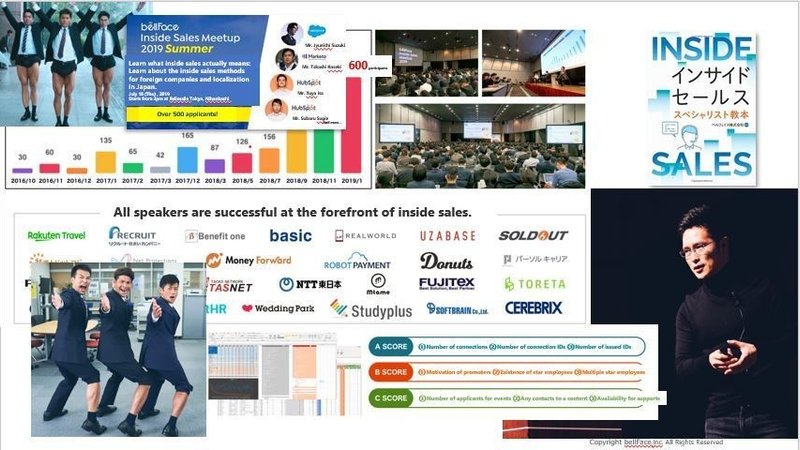
bellFace has not “gone with the flow of the trends”.
We have “created the trends”.
The number of paying introduction companies has exceeded 1,000 at our fourth anniversary, but it has only started. We are going to make continuous efforts in domestic sales market as it should be 30 times more than just the inside sales market.
------------------------------------------
Beside sales, there are areas where innovation is not happening at all, although it is very important for all employees.

There are not any other areas, such as human resource, where definition is unclear, and each company has different perceptions and awareness towards labor management. As a matter of fact, except for companies with no evaluation systems, most companies, including large enterprises, would probably face the same situations.
《General personnel system》
■ There are “grades” based on the levels of work performance.
・level 1 = “I can perform if I have instructions”.
・level 2 = “I can perform independently without any instructions”, and
■ The position will go up based on the grades.
■ It is divided into “general occupations” and “professional occupations.
And finally, the annual income is decided based on a regular “payroll structure”.
It has been 12 years since I had established this business at the age of 21, however this “common” personnel system has felt “not quite right” to me for many years.
Something is missing…
Something is fundamentally missing the point…
bellFace will soon have more than 100 employees, and will it be possible to hire talented people in the HR system based on the grades and the payroll structure? Will it make them stay with us? Can we be competitive in the worldwide market? I have been wondering these questions for years.
One day, someone introduced me to a book called NETFLIX’s Strongest Personnel Strategy, which struck my heart (I could be slightly exaggerating). It felt like things that had kept bothering me for years have suddenly solved.
What the traditional personnel system completely overlooks is the “market values” of human resources. The “market values” mean “supply and demand”.
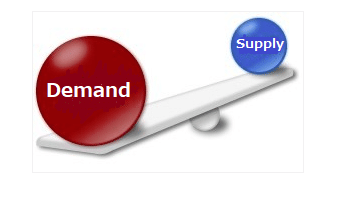
If you think about it logically, the value of human resources changes depending on the market.
◆ If there are not enough engineers in the market, the demand (rewards) for engineers will rise, and vies versa. ※ For example, in India, 1.5 million engineering majors graduate each year, but approximately 500,000 people are able to find a job, which is oversupply of human resources and it leads to the decrease in their salaries.
◆ If there are not enough inside sales personnel in the market, the demand (rewards) for inside sales will rise, and vies versa.
◆ Because the applicants for clerical work are in “oversupply”, the rewards are “low”.
The value (renumeration) of human resources is determined by supply and demand (market principle).
Everyone knows how it works.
…However,
It (the market values) is not considered at all in the personnel system. No, that is not correct. It is considered.
Only when they are “hiring”.
At the time of hiring, based on the salary from the previous job, the new salary is calculated while comparing with other companies.
“As our competitors are recruiting marketers offering the annual income of 7 million yen, so we should offer 7.5 million yen per annum.” “Other competitors are offering 6 million yen per annum, so we should offer 7 million yen.”
Such conversations occur because of the “market principles”.
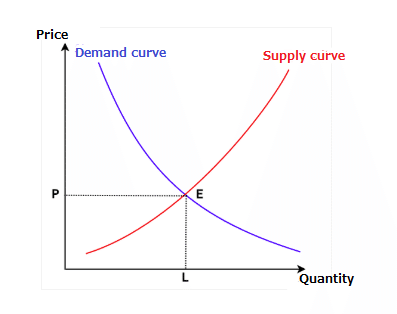
However, for some strange reason, the “market principle” is not reflected at all in the personnel system “following the recruiting process”.
Showa era, when everyone’s purpose of life was to receive pension, is over, as well as the peaceful Heisei era. Now, it is a new Reiwa era. In this modernized employment situation, employees have no obligation or responsibility to continue working at the same company. They always have the option to change jobs.
Having said that, however, it is difficult to recruit. But because we have created a system from the perspective of companies that misunderstood the meaning of a “selectable position” even after many years, we may have overlooked such a matter of course.
“We will reflect the “market evaluation” in our personnel system and pay the highest level of rewards in the industry so that the best personnel would work with us at bellFace for a long time.”
I have made up my mind and started designing the system with our HR department.
----------------------------------------
The calculation of the market evaluation was realized relatively easily with the help from “recruitment agencies”.
Step①
Employees update their career sheets (CV) once a year.
※ Performance during employment at bellFace is considered.
Step②
Submit the career sheet to 3 recruitment agencies, estimate the “range of rewards that the same job type and position will receive when they change jobs”, and average the maximum amount.
※ Select a partner who is familiar with each job type to improve the accuracy of the estimate.
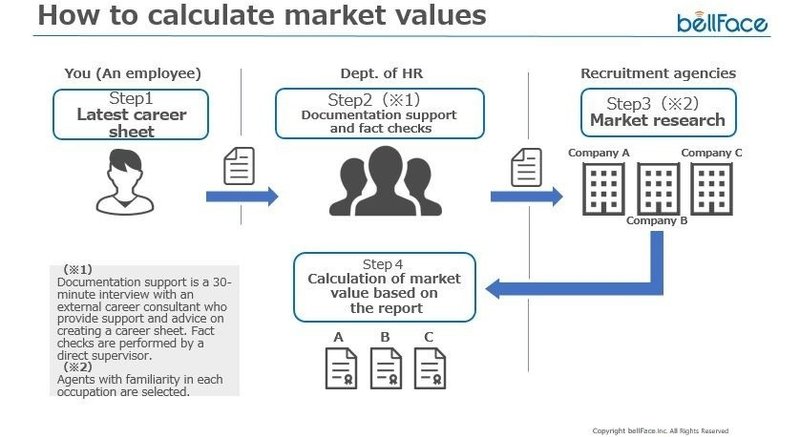
Very simple.
By averaging the upper limit of the range of renumerations estimated by the 3 recruitment agencies, we can calculate the “top-level renumerations in the industry” of human resources without any mistakes.
Moreover, employees have the benefit of receiving advice from professional career consultant (outside) in preparing their career sheet (CV).

In addition, on the report card from recruitment agencies,
✅ A base of renumeration calculations (addition / deduction points) is shown, as well as
✅ Career advice on how to rise your market value while gaining careers and performances in the future.
You could not ask for more.

In other words, employees at bellFace can “understand their market values every year without changing their jobs and think about their career in the med-long term based on experts’ advice”.
※ “New graduates” are not evaluated in the market unless they gain certain experiences in their career.
It was a moment when many years of my restless feeling had finally gone.
By the way, the recruitment agencies do not perform this time-consuming estimate work for free of charge. 1 report card costs tens of thousands of yen, times 3 agencies, and then multiplied by the number of employees. bellFace spends “a few million yen” in one personnel evaluation. As a venture enterprise, it is not a “slight deal” for us.
However, I believe that this is a valuable investment if our talented people feel appreciated and will stay with us for a long time.
-------However, a question has popped in my head----------
✅ Even if we pay the industry’s highest level of remunerations, that person is “not always capable of achieving the best results at bellFace.”
I felt that the idea of the American venture (Netflix), where anything will be possible if they succeed in acquiring human resources with Google or Facebook along with the vast financial power, is not always applicable. Furthermore, I also felt that:
✅ I would like to pay “more than” the highest level in the industry to first-class personnel.
We are an IT enterprise with no stock or equipment. We can only invest in “people”. We also engage in a SaaS business that builds up MRR (monthly stock income). There is no need to be stingy on rewards for people who contribute to the company.
So, what is the definition of “superior” = “high performers” for bellFace? This has been clear from the start.
They should have 3 qualities of “logical thinking ability”, “execution ability”, and “human relationship building ability”,

make efforts to embody the values (= 6 Values) that bellFace acknowledges,

and “as a result”,
achieve the given missions (achievement targets).

◆ “Values” are, in a rapidly changing environment, the criteria for each employee to make decisions on the spot or a stance that everyone should always be aware of.
◆ “Missions” are performance targets for each employee to achieve a business plan.
If I could reflect “values” and “missions” based on market evaluation, I believe that it could be the best personnel system.
----------------------------------------------------
《Value Evaluation》
Since its establishment, a strong company has “characteristics (personality)”, and there was a belief that their “bias” would create a strong organization. For example, there are no doubt that strong organizations, such as Recruit, Cyber Agent, Rakuten, Keyence, and Optical Communications in Japan, have “characteristics”. That is exactly what I mean by “values”.
Regrettably, I could not create such organization for my first attempt to establish a company, therefore I have made efforts to clarify and instill its values at an early stage of establishing bellFace.
Needless to say, there is no point in creating values and philosophies if they become unenforced. (There are so many companies like that.) In order to avoid that situation, it is important for a company to link them with the personnel system. As a method, at bellFace, we have decided to score 6 Values in a 360°survey and introduce 4 ranks with S / A / B / C.
【Step1】Selection of members for the 360 ° survey (6 persons, including supervisors, evaluate 1 person)

【Step2】Respondents rate the 6 Values in 4 stages.

As mentioned above, they could score the value expressions of all employees in the range of [min 42 to max 168 points].
Then, it is finally divided into 4 value ranks. If it is a company of 100 employees, it will be divided as [Top 25 people = S] [Next 25 people = A] [Next 25 people = B] [Lower 25 people = C].
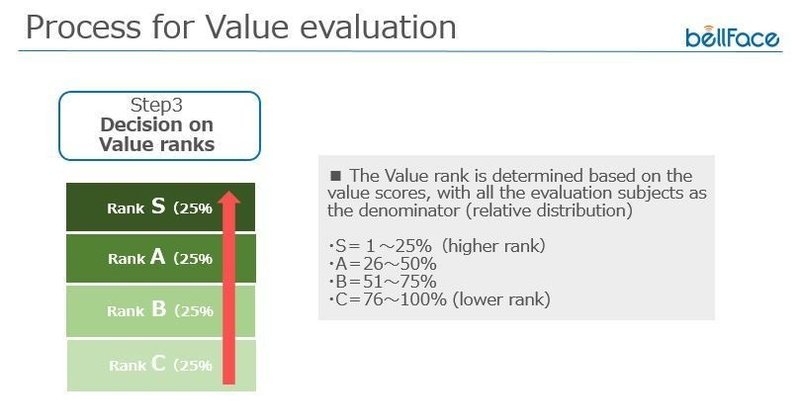
By the way, someone in our organization has questioned why we do not have an “absolute rating” system such as “Value score above ●● points will receive A”. The answer to that question is simple. It is because there is no end to the pursuit of values, and the levels sought by the organization and its business stages are constantly changing.
For example, the “ownership” evaluated by the current bellFace and the “ownership” required by bellFace within a year, where the number of employees and sales will be double, are naturally different.
If the number of excellent associates increases and existing employees make an effort, the standard will continue to rise. We call it “growth”. Therefore, only values should be relatively evaluated in the future.

Another question raised was: “Wouldn’t it be unfair that new graduates and business managers have the same evaluation criteria?”. That is not a problem either because assessments for a new graduate are done by other new graduates in the same position (and by their supervisors), and assessments for a business manager are done by other business managers (and executive officers) in the same position.
Of course, the level of standards required by the position is different, so in the value evaluation, “a new graduate sometimes scores above the head of department” naturally. In other words, people from any position are evaluated equally based on the values.
※ “The importance of being an executive officer” has already been rewarded with market valuations.
《Mission Evaluation》
Mission (performance targets) evaluation is easy to understand.

Targets are set on a semi-annual basis and classified into 4 ranks (A to C) based on their degree of achievement. What makes it slightly distinctive is that it is set for “everyone” including engineers and accountants that are generally difficult to set targets, as well as departments with clear figures such as sales department.
If any work is subdivided, it should be replaced by numbers, and even with tasks that cannot be quantified with numbers it should be possible to set a qualitative target based on when and what circumstances will be achievable. (If A makes it 100%, S means more, and B means less than that evaluation figure.)
In my opinion, however, one would vent their frustration against the personnel system when they are told they are not good enough at the time of evaluation even though their concrete targets are not clearly set.

Which means that it is a fundamental problem that managers and their subordinates do not comprehend as to what the “performance results” are. Even if it is difficult, they should put it together first and share the progress at least every month, so that even managers and engineers can evaluate the mission “achievement” for a certain period.
In other words, because of this mechanism, the performance outcomes in any type of work “must be clarified”.
It is crucial to communicate with one another like “I am a designer, what kind of mission should I set?”.

An executive officer asked me, “Wouldn’t it encourage them to set lower and negative missions because it is easier to achieve them?”, but that is not a problem. That is because the missions finally set for an employee is “assigned from the top” in order of management → division manager → manager → player to achieve their business plan, and the employee does not set it by themselves.
Through this process, we were able to quantify (rank) values and missions. Finally, I am going to explain how to combine them with market valuations.

The idea is simple.
Based on the “industry’s top-level remunerations” calculated in the market evaluation, add / subtract at the following % according to ranks for Values / Missions.
・S rank = + 10%
・A rank = + 5%
・B rank = -5%
・C rank = -10%

A calculation would look like as follows. ※Click to enlarge image.
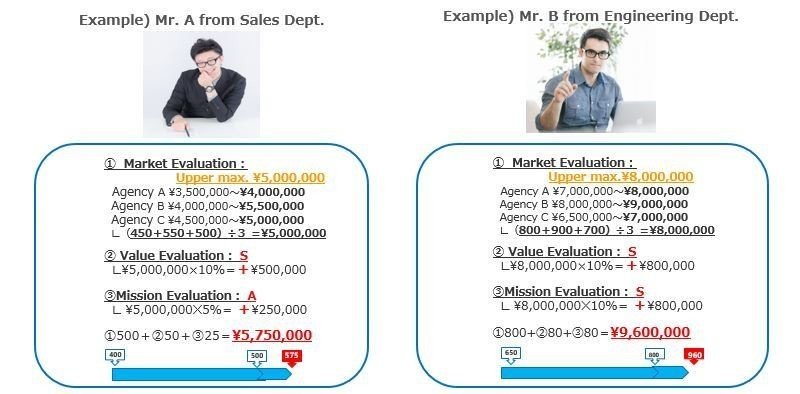
For example, if an employee’s Value / Mission is ranked “S”, whose upper limit of his/her remuneration is 8 million yen p/a, it is possible for him/her to receive a remuneration of 9,600,000 yen p/a. As you can see, it is based on “the highest level in the industry”, so employees with high Value / Mission scores will inevitably be paid “above” the highest level. Furthermore, the reward level is quite high.
※ In addition, bellFace offers another “performance achievement bonus” for all employees.
On the other hand, how likely would it be for a remuneration to “fall” to the maximum level?
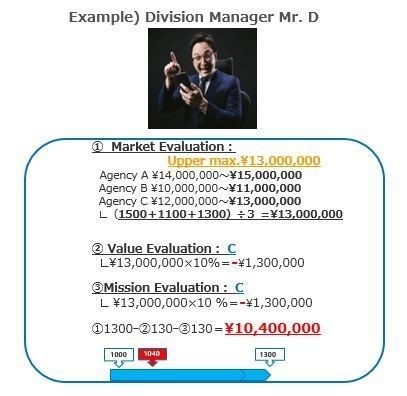
In this case, the average remuneration range is 12 to 13 million yen p/a, and the actual remuneration is “10,400,000 yen p/a”. This employee could achieve higher goals or, in some cases, change jobs. After all, there is a “latest job record”, and it has been proved that if they change their jobs, they are likely to increase their remunerations.
There are pros and cons to this system, however I believe this is the way it should be.
In summary, there are 3 ways employees at bellFace can increase their remunerations.
◆ Increasing your market value = Long-term efforts
◆ Increasing your Values = Short-mid-term efforts
◆ Achieving your Missions = Short-term efforts

Employees at bellFace can always check their “market values” and create career paths systematically without having to change their jobs. Furthermore, by embodying Values and achieving Missions, they will receive “more than” the industry’s highest level of remunerations.
With this system, employees become aware of their own career (market value) without trying to figure it out, and the supervisors who evaluate it will be face to face with their subordinates and seriously consider the ways to increase market values and to raise the rewards for their subordinates.
At bellFace, we declare that we are more of a professional team where everyone is committed to their work, rather and a family, and that your career is your responsibility, not the company’s.
Because of that, there are various career support systems, and an environment in which all types of work can be performed remotely, and flexible working hours has been established in the premise of “freedom” and “responsibility”.
In today’s society where the idea of permanent employment and pensions is crumbling, will it really be good for employees to evaluate only with closed internal evaluations and salary structures?
I do not think so.
In this personnel system, I aimed for our employees to be “human resources with high market values”, “those who can embody Values”, and “those who can accomplish the Missions as a professional”.
The HR system at bellFace, which combines market assessment, Missions and Values, may become the standard in the highly competitive IT industry.
この記事が気に入ったらサポートをしてみませんか?
